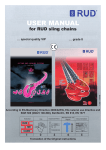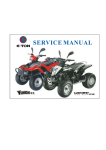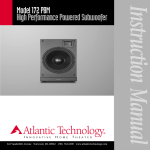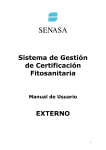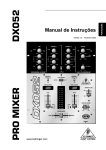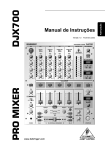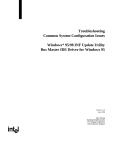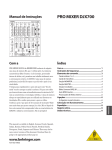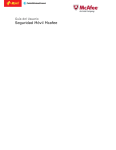Download USER MANUAL - Ritchies Training Centre
Transcript
RUD ME CANO LIFTING MEANS USER MANUAL for RUD sling chains … special quality VIP … grade 8 According to Machinery Directive EG – RL 98/37 EG, EG material use directive and BGR 500, EN 818, EN 1677 Selection RUD ME CANO Use Inspection / Test Maintenance and Repair Documentation RUD ME CANO Determined usage for lifting and transportation of loads 1.1 Asymmetrical loads If one leg must be shortenend in multiple leg application could this be an indication for an uneven load. The nominal WLL has to be reduced by 30%. For load factors please refer to the following chart. 1. Selection of sling chains 1.1 The weight of the corresponding load must be known. 1.2 The center of gravity from the load must be known. 1.3 Method of sling For muliple leg lifting the inclined angle must be between 15° and 60° from the vertical. Angles exceeding 60° creating overloading in the legs. Angles less than 15° can create instability. When using choke hitch, the WLL has to be reduced accordingly. Generally it is always possible with a 4 leg lifting that only 2 legs are carriying the load even the load is symmetrical. 1.5 WLL in metric tons for symmetrical conditions RUDLifting means in special quality 1-strand Inclination angle ß 0 0-45° 45-60° 0-45° 45-60° Inclination angle ß Load factor 1 1,4 1,0 2,1 1,5 Load factor EN-818 Grade 8 3- and 4-strand 2-strand Nom. chain size Nom. chain size VIP 4 0,63 0,88 0,63 1,32 0,95 6 1,12 1,6 1,12 2,36 1,7 VIP 6 1,5 2,1 1,5 3,15 2,25 8 2,0 2,8 2,0 4,25 3,0 VIP 8 2,5 3,5 2,5 5,25 3,75 10 3,15 4,25 3,15 6,7 4,75 VIP 10 4,0 5,5 4,0 8,4 6,0 13 5,3 7,5 5,3 11,2 8,0 VIP 13 6,5 9,1 6,5 13,65 9,75 16 8,0 11,2 8,0 17,0 11,8 VIP 16 10,0 14,0 10,0 21,0 15,0 18 VIP 20 10,0 16,0 14,0 22,4 10,0 16,0 21,0 33,6 15,0 24,0 18 22 15,0 21,0 15,0 32,0 22,4 22 VIP 22 20,0 28,0 20,0 42,0 30,0 20,0 28,0 20,0 42,0 30,0 26 In case of assymmetrical loads the load factors are: 1 1 1 1,5 1 6 8 10 13 16 26 RUD ME LIFTING MEANS CANO Dimension X prevents from the assembly of bigger chain size. The diameter Y of the load pin prevents from a connection of a smaller chain size. 1.6 RUD MECANO assembly system for Special quality VIP and Grade 80 RUD master links are delivered complete with fully captive connectors VRG. Therefore only the correct chain size and correct number of legs can be assembled. The identification tag with integrated chain testing gauge is already attached. Load – and retaining pins are supplied pre – assembled. Only RUD chains and RUD components with the same nominal size can be assembled. - Special quality VIP: For asembly please use only chains, components and pins stamped with VIP-H1-8S 1.6 Assembly system INTER-LINE-SYSTEM Please note: Universal system, chains and components are non fool proof assembled with VS-hammerlock. - Identification must be correct - Use retaining pins only once - Use only RUD original spare parts - Use retaining pins only once - Use only RUD original spare parts - Do not mix with chains and components from higher quality classes e.g. VIP ... Please pay attention to the following regualtions: = identification of saaembled chains slings. = the sign confirm that technical requirements of the Europeam standards NORM – CEN are fulfilled. proof - Grade 80: For assembly please use only chains, components and pins stamped with H1-8 - Slot of the retaining pin must be visible from outside Identification tags must be assembled seperately. fool – Please note: With other systems using grooved pins it is necessary first to select the correct pin for the component. With the RUD MECANO system the assembly is very simple. Additional the system is fool proo, therefore it is inevitably that the correct chain size will be attached. It is a necessity to pay particular attention that for assembly or repair, chains, masterlinks and components are from the same nomonal size. Clevis m syste EN 818-1 / EN 818-2 / EN 818 – 4/ EN 1677 BGR 500 and country specific statutory regulations. We do not take any responsibility for damages occurred by non-respecting these standards, regulations and above mentioned hints. rsale v i n U m Syste o Non fo f l proo 2. Usage for lifting chains When using lifting chain assemblies, attention must be paid according the regulations BGR 500 chapter 2.8 "Betreiben von Lastaufnahmeeionrichtungen im Hebezeugbetrieb“ or other specific country statutory regulations.Whenever it is possible leave the danger zone.Never leave lifted loads unattended. Be sure before the first lift that: the chain assembly corresponds to the ordered ones the test certificarte 3.1B or the factory approval 2.1 ( form DIN 50049/EN 10204 inclusive the details from EN 818-4) and decleration of confirmity is present. The details marked on the identification tag of the chain assembly corresponds to the specification on the test certificate and the decleration of confirmity. - The details are in the chain card file. This documentation should include a description of the chain assembly, as well as the Identitätsnachweis (Test certificate resp. decleration of confirmity/ ref. no.) 2.1 Handling Lifting chains must be used with straight legs without twists or knots. Lifting hooks are not designed for tip loading amd must have saftey latches to avoid unintentional unloading. Master links must be free moveable at the bowl of the crane hook.Avoid shock loading. Sharp corners are damaging chain links and components. In this case use edge protection, next bigger chain size or reduce the WLL by 20%. VIP-Multishortening claw VMVK Dir ect ion of p ull Direction of pull Do not load stick chains Do not load stick chains Fitting: Pull loose chain strand through the crucifix. Secure the chain in the looking pocket at the required position and drive in the retaining pin. A. Thus the multi shortening claw is fixed in the VIP chain strand. It is preferable to fit and secure on the third chain link down for maximum adjustment. Slide the chain into the slot and secure. Handling: Laterally swing out VMVK. With the chain strand slack, insert the required chain link into the pocket of the VMVK 1 , pull down chain strand 2. If required depress securing bolt. Securing bolt locks automatically. Check locking. For unlocking, reverse procedure. Depress securing bolt 3 at the same time. Attention: If the VMVK A is used without securing bolt the chain must always be completely seated in the locking slot B ! When pulling / fitting the shortened chain assembly attention must be paid to ensure that the chain remains in the locking slot B until the lift has been completed. User advice It makes it easier for a chain basket assembly. Always let the loose chain face downwards Loading Loading 2.2 Multi – leg sling chains, where not all individual legs are used: Application of the lifting means Number of individual used legs 2-leg 3- and 4-legs 3- and 4-legs 1 2 1 1/2 2/3 1/3 2.3 Storage of sling chains Sling chains should be stored on racks in hanging conditions. environments such as steel production, forges, foundries etc. ) the WLL has to reduced acc. The following table. 2.4 Influences of high and low temperature If sling chains of quality class 8 or higher such as VIP are to be in temperatures ranging from 200°C upwards (e.g. in hot °C % -40° to +200°C 100% Load factor for the nominal WLL Reduced WLL in % where the chain slings reaches temperatures of: beyond 200° up to 300° 90% above 300° to 400° 75% With lower temperatures, the sling chains must not be used because of their sensitivity against brittle failure. VIP overheat indicator for pink powder coated chain. nt -Pate The special fluorescent pink powder coating signals permanently the maximum temperature at which the VIP chain had been used. The pink colour changes to black when the chain is used in temperature areas highre than 400°C (forbidden) and starts to bubble. Replace VIP chains or return to manufacturer for inspection. 2.5 Chemical influences 2.6 Other influences Sling chains of quality class 8 or VIP special quality are not be used under influences such as acids, alkaline solutions and vapours e.g. in pickling baths or hot dip galvanising plants. When using sling chains in highly concentrated chemicals, the manufacturer must be contacted first regarding the concentration, period of penetration and temperature of use. Attention should be paid to special instructions such as BGR 500 or other country specific statutory regulations. ed- 3. Inspection and test 3.1 Visual and function test For controlling sling chains, regular inspection by an expert have to be carried out within a period of 12 months. Depending on the conditions of use e.g. permanent usage, increased wearness or corrosion the inspection needs to be carried out earlier. The examination has to be recorded in the chain card life. Protocols of tests and any other records have to be kept. Should any of the following damage occur the sling chain should immediately be taken out for service: a) the identification tag is unreadable or the tag is missing b) twisting, deformation and breakage of components and master links c) lenghtening of the chain by plastic elongation (deformation) of individual links by more than 5% refered to the pitch of 3d. d) wear occurs at the chain links caused by abrasion on the outside and between chain links hanging together. For measuring the wear with a caliber, the chian must be loose. A wear up to 10 % (dm) is permissible. dm = average link width d1/d2 = actual sizes d = nominal size e) cuts, grooves, notches, failure, increased corrosion, discolouring due to heat, bent or twisted chains and components. f) At the lifting hook, the widening of the hook must not exceed 10 % of the nominal value. The hook securing (safety latch) must still slip into the hook tip in order to occur form closure. Carefully examine bowl of the hook for notches. 3.2 Examination for cracks A magnetic crack test must be done latest every 3 years for lifting chains and components. Fundamentely with VIP chains and components. Proof load test, for chains and components is insufficient because cracks can only be recognized with a magnetic crack test. VIP identification tag with integrated chain testing gauge Testing wear of nominal diameter Testing pitch elongation caused by wear of nominal diameter Testing plastic elongation caused by overloading 4. Repair and Maintenance Repair works have only to be done by experts, disposing of the knowledge and skills required.Components with failures, being bent, twisted and considerably deformed must be replaced. With the chain, the complete leg has to be replaced. Minor faults such as notches and grooves have carefully to be grind off (No notch effecxt). The cross section of the material must not be decreased by more tha 10 %, inclusive the load pins. Welding on chains and components are forbidden. When exchanging chains or components use new load and retaining pins only. Any repairs, maintenance carried out have to be recorded in the chain card file. Use only original RUD spare parts. It is only alllowed to connect VIP chains with VIP components. (Pink coloured and VIP stamped) It is not allowed to combine VIP chains and components with chains and components quality class 8 or lower. 5. Documentation in a chain card file The chain card file contains the continue history of a chain sling. The contents are a first record (paragr. 2), inspection / test dates (paragr.3) as well as repair and maintenance ( paragr.4). In case of repair, the reason for that repair has to be indicated. The records in the chain card life give proof on steady supervision measurements of the user during the use of the sling chains. REGISTRATION VISUAL CONTROL Carefully adhere to statutory requirements and the approval code of practise issued by the trade association. Our test personnel are well educated specialists according EN 473 working with the most modern equipement. Test cerificate according BGR 500 as well as actual EU law. RUD chain inspection service in Germany Testing equals safety and keeps the value added. MEASURING CRACK TESTING R BG MAINTENANCE The RUD inspection service offers you the complete safety service directly on the field. We are testing every lifting means accord. the beside mentioned 6 points safety program. CERTIFICATION Service phone: + 49 7361 504 1370 Ahead of its time ! Further RUD-products for any applications: RUD-Art-Nr.: 7982411/07.004 Conveyor systems Lifting and Lashing Systems Hoist chains








